If you're in marketing, communications, or pretty much any digital discipline, you've already heard of content strategy. Or perhaps your organization is experiencing pain related to content, such as these direct quotes from clients:
- "We aren't telling a cohesive story, and it shows in our lack of conversions."
- "We're wasting time and money rewriting the same or similar content over and over."
- "Our customers are confused because we say one thing on our website, another on our packaging, and another when people call or email us."
- "We can't manage all the content we have, and we're always creating more."
- "We can't prove whether the content we're creating is really boosting our brand or the bottom line."
- "Content is a political minefield, and either everyone thinks they're in charge or no one wants to be."
- "We don't have any guidelines that allow us to say no to content we don't think is necessary or on-brand."
- "No one wants to take responsibility for ensuring that our content is still up to date. Or they just don't have time to deal with it."
Maybe you've been asked to take on the task of developing a content strategy for a website redesign, or you're participating in developing or implementing a content strategy. In any case, you're not sure what you're getting into or where to start.
Behold! Here's a roadmap.
What Is Content Strategy?
It's probably a good idea to start with a definition. Here's mine:
Content strategy helps organizations provide the right content, to the right people, at the right times, for the right reasons.
"For the right reasons" is the most important phrase in that definition. Without clarity about the "why"—the purpose—it's almost impossible for content to meet user needs or achieve business goals. Content strategy defines content purpose, and then guides planning for the creation, publication, and maintenance of that content.
Perhaps you've heard of Brain Traffic's content strategy quad shown in Figure 1. That's the framework I use to understand and explain content strategy.
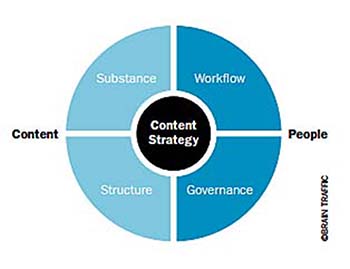
Figure 1 Content strategy framework from Brain Traffic.
The quad framework makes a lot of sense because it binds together everything that goes into creating successful content experiences, organized by purpose. The inner circle of the quad is the core content strategy—the content's purpose.
Surrounding the core strategy are four quadrants:
- Substance defines what content the organization should produce, how it should sound, and why it's meaningful or relevant to users.
- Structure refers to how content is organized and displayed, so users can find and use the content they need.
- Workflow is how content flows through the organization—from ideation to publication to ongoing maintenance.
- Governance details how the organization makes decisions about content to ensure that it's on-strategy.
Okay, I think we're on the same page now about what content strategy is.
First Things First: Sell Your Boss on Content Strategy
Often the first step in a content strategy project is convincing others within an organization that a content strategy project is necessary. You do that in several ways:
- Identifying and quantifying problems with your content, and repositioning them as opportunities.
- Making a strong business case for how seizing those opportunities can help the organization to succeed.
- Asking for the time and money necessary to achieve business goals with content.
In the book: Chapter 1, "Identify the Problems and Opportunities," is about selling the need for content strategy, with a presentation template you can use to make your pitch.
Next Up: Make Friends with Stakeholders
Trust me when I say that stakeholder involvement and alignment is key to your project's success. That's why you need to have empathy for your stakeholders' needs and involve them from the very beginning.
To get started, make a list of your stakeholders. There are several types, as shown in Figure 2, and you need all of them.
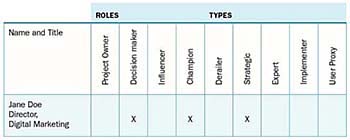
Figure 2 Stakeholder matrix example showing names, titles, and roles.
Once you have your list, document what you'll talk to the stakeholders about, what concerns they're likely to have, and how you'll sell them on this content strategy thing (see Figure 3).

Figure 3 Stakeholder matrix example showing topics to cover, concerns, and the project pitch for the listed stakeholder.
Next, figure out how you'll get the stakeholders' input, and invite them to participate. Interviews and working sessions are great ways to pick their brains and uncover alignment and misalignment across the organization.
In the book: Look to the chapters in Part III, "Dig In and Get the Dirt," to find a sample email message you can send to stakeholders, plus a sample project kick-off agenda and plan to help you get stakeholders on board and aligned.
Finally, Do the Content Strategy Stuff
Truth time: There's no one right way to do content strategy. My projects look a little different every time based on budgets, timelines, business goals, content complexity, and lots of other factors.
I do, however, follow a pretty standard framework that I adapt and evolve for each project. Every single project includes the following four stages:
- Discovery
- Definition
- Design
- Doing
I don't use this list in the book, but I realized when writing this article that having four d-words was pretty cool.
The activities and deliverables in each stage depend on the project. More about deliverables (another d-word!) when we get to the definition and design stages.
Stage 1: Discovery
During a discovery phase, I need to learn what the business or organization is trying to accomplish overall and with its content; what their audiences need and expect from them; how external factors like competitors and industry trends affect their work; how they plan and create content; and what content they currently have, where it lives, and its current condition. With that information in hand, I can make sound content-strategy recommendations that help my clients to achieve their business goals.
You might be tempted to skip this step, especially if you feel like you know all the information already or it's all documented somewhere. Don't skip it. At the very least, review what documentation you have and identify gaps in knowledge. Then talk to stakeholders to fill those gaps.
When you're done, summarize what you've learned and make sure that stakeholders are on board with the goals and user needs you've identified. Often you can move from that point right into the next phase. If you're not sure whether you're ready to move forward yet, tally up the points in the matrix in Figure 4. If your score is between 0 and 2, stop and align with a summary first. If your score is between 3 and 5, keep moving.
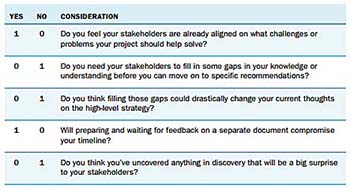
Figure 4 "Is my organization ready?" scoring matrix.
In the book: Dive deeper into Section III of the book to uncover all the information you'll need, and get your hands on several tools to help you along the way, including a stakeholder interview guide, a workbook to keep and analyze your discovery insights, and ideas for workshop activities to help you understand your users.
Stage 2: Definition
In the definition phase, you set your content compass to ensure that you're providing the right content, to the right people, at the right times, for the right reasons. In this phase, you also define how you'll measure whether your content and content strategy is successful.
Content Compass
Let's start with the content compass, which encapsulates what you're trying to achieve with your content, the target audience for the content, and what you want your audience to know or believe. I typically create two deliverables for my clients to communicate their content compass. The first is a core strategy statement that looks something like Figure 5.

Figure 5 Core content strategy statement example.
The statement serves as a litmus test to help you decide what content you need and why. Consider the ideas in Figure 6 in light of the example core strategy statement.
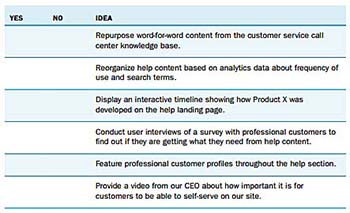
Figure 6 Ideas for consideration.
Did you say yes to some and no to some others? Great. That's how it's supposed to work.
The second content compass deliverable is a messaging framework that outlines what you want your audiences to believe about you and why they should believe it. Like the core strategy statement, it helps organizations to decide what content to produce in support of their strategy. It can be documented very simply, as Figure 7 demonstrates.
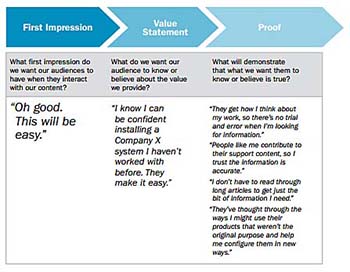
Figure 7 Messaging framework example.
In the book: Chapter 11, "Create a Content Compass," provides how-to instructions to develop core content strategy statements and messaging frameworks. This chapter also provides tools to help you develop and document your content compass deliverables.
Measurement
Defining how you'll measure success is just as important as creating content. Start by deciding what you'll measure—your key performance indicators (KPIs)—and how you'll measure those KPIs (using tools called metrics). The KPIs should tie to the business goals and content objectives you set early in your project. After you've thought through all that, put together a summary of how you'll measure success, and make a plan to do it. Your summary might look something like Figure 8.
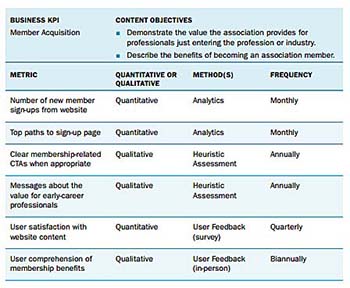
Figure 8 Sample KPIs, content objectives, and metrics documentation.
Then do it. Really! Don't forget to measure, report on your findings, and use what you learn to make content decisions going forward. Figure 9 shows an example excerpt from a measurement report.
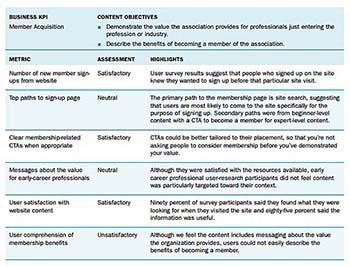
Figure 9 Scorecard sample.
In the book: Read Chapter 12, "Decide How You'll Measure Success," for details on different ways to measure content effectiveness. A sample measurement report is included so you don't have to start from scratch.
Stage 3: Design
I use the term design or content design to wrap up things like information architecture, sitemaps, wireframes, content models, templates, and page outlines. Content design involves four separate but closely related aspects of content:
- Content prioritization is how you determine what content you need and its relevant importance to your users or your business. To document prioritization, you might create something like a topic map or content matrix (see Figure 10).
- Decide how to organize the content so that people can find it. Deliverables you might produce include sitemaps, user flows, and taxonomies.
- Determine how to present the content in the various ways a user might interact with it. You might document presentation with content models and wireframes.
- Specify the requirements for each type of content, and possibly each individual piece. Page tables and personalization matrices are artifacts you might produce to document specifications. Figure 11 shows an example of a page table.

Figure 10 Content prioritization sample.
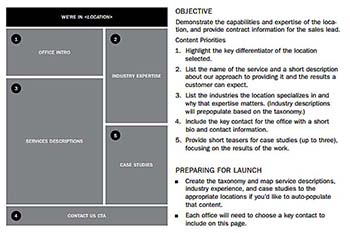
Figure 11 Page table example.
In the book: Chapter 13, "Design Your Content," is chock-full of instructions and tools to help you with content prioritization, organization, presentation, and specifications.
Stage 4: Doing
Now it's time to put your strategy into action. I usually separate the "doing" stage into two phases: getting to launch and maintenance.
Getting to Launch
To get to launch, you need to decide who is doing what and what process they'll follow to create, approve, and publish the content. Make sure that everyone involved in creating content understands what's expected from them. You can communicate roles, responsibilities, and processes with some pretty simple deliverables. Figure 12 illustrates how you might document a step in the content creation process.
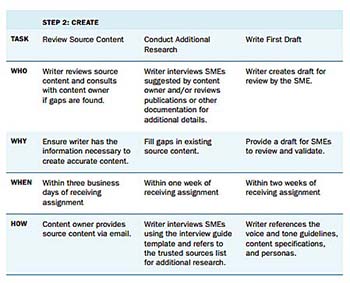
Figure 12 Example of process documentation.
One of the most important reasons for creating content is to give people the tools necessary to do their work within the bounds of your process. Provide a style guide so that writers know how to write for your brand and in accordance with your strategy. Give reviewers a checklist so they know exactly what to look for when providing feedback on content. Trust me—tools like these make life easier for everyone involved.
In the book: You need to account for certain roles and responsibilities, and Chapter 15, "Plan and Maintain Over Time," provides detailed examples. You'll also find tools you can use to ensure that your content hits the mark.
Maintenance
When content is first published, its life has only just begun. You will have to update the content over time for many reasons; it might become outdated, you might need to change how you explain a product or service, the company's strategy might change. You get the idea. Make sure that you have a plan for how to maintain the content.
I like to develop a process to prepare for both planned and unplanned maintenance. You will need to plan for certain content updates. For example, you might need to conduct an audit of your content and use the results to determine what updates you need to make. You can plan for such maintenance needs, manage them like mini projects. Figure 13 shows how that process might look.
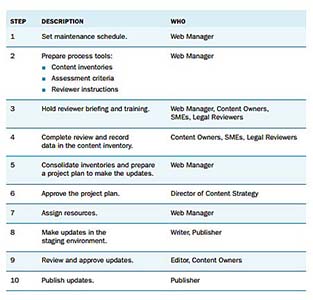
Figure 13 Example of process documentation.
Unplanned maintenance, on the other hand, addresses things that come up without advance notice. For example, a product is discontinued with little notice or legislation, requiring you to update all the disclosures on the site. These types of changes can take a lot of time and throw a wrench into your other work. But having a plan and process for prioritizing and dealing with such requests can help.
In the book: Chapter 15 provides more details on setting up your maintenance and planning processes, plus some tools to keep your content fresh.
Onward!
Of course, I can't tell you everything you need to know in one short article, but I've given you a place to start. A wealth of resources are available, including a bunch of really smart people who do this type of work professionally. To find it all, I recommend checking out Jonathon Coleman's "Epic List of Content Strategy Resources." And get my book, The Content Strategy Toolkit: Methods, Guidelines, and Templates for Getting Content Right.

